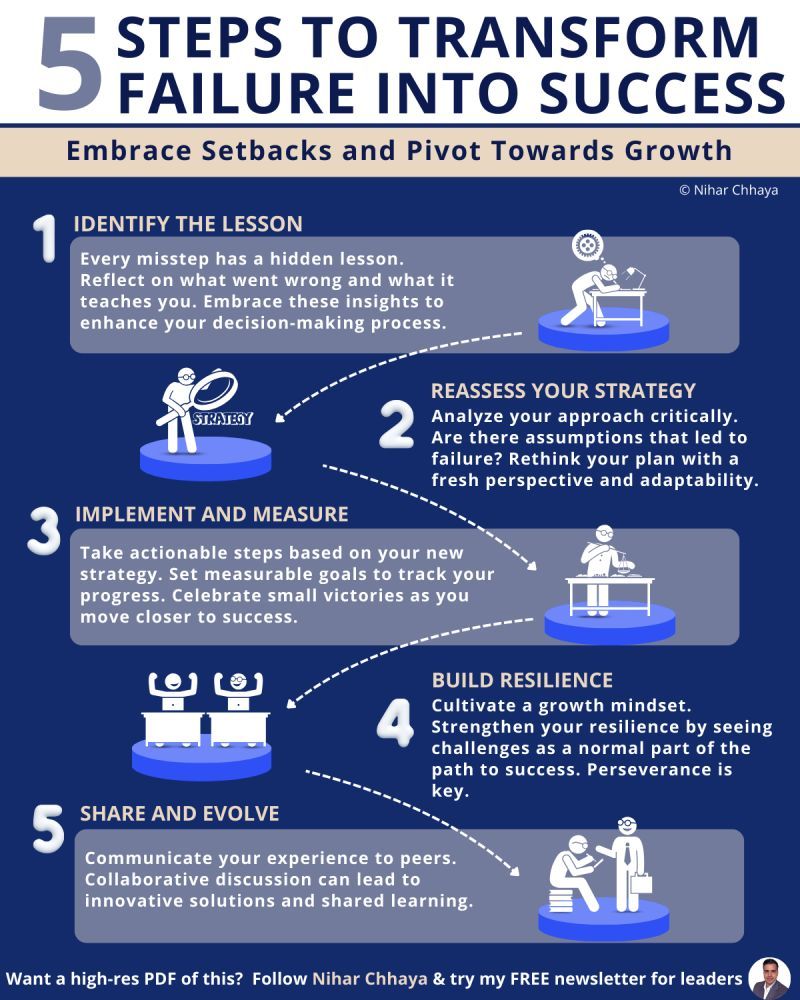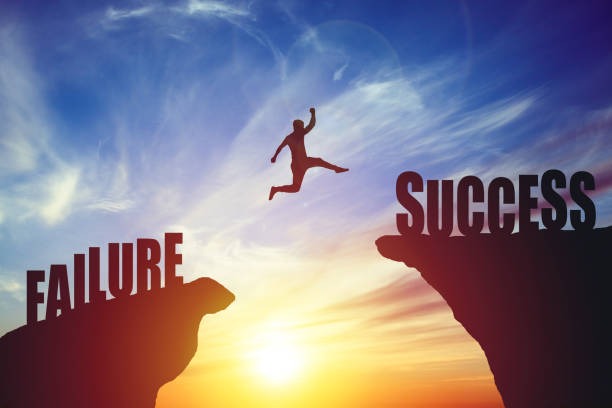Redefining Failure
Failure. Just the word can trigger a surge of emotions—shame, fear, embarrassment, regret. In a world obsessed with winning, where social media constantly showcases filtered versions of success, failure is often perceived as a personal catastrophe rather than a stepping stone. But this perception isn’t just unfair—it’s harmful.
Contrary to popular belief, failure is not the opposite of success, but a critical part of the journey toward it. As highlighted by Harvard Business Review, many of the world’s most impactful innovations and personal growth stories began with initial failures.
Still, emotionally, failure can feel crushing. Research from the American Psychological Association (APA) reveals that failure can activate brain regions associated with pain and emotional distress. That’s why failure isn’t just disappointing—it’s physiologically stressful, triggering the same responses as physical harm.
But here’s the truth: failure is universal. It is not reserved for the weak, the underprepared, or the unlucky. Even the most successful entrepreneurs, including Steve Jobs and Elon Musk, have experienced significant professional setbacks, as documented in this Business Insider roundup.
This article will explore how to handle failure in a healthy, empowering way. From immediate emotional responses to long-term mindset shifts and practical habits, we’ll dive deep into what it really means to fail—and how you can rise stronger every time you do.
The Psychology of Failure: Why It Hurts So Much
Failure doesn’t just sting emotionally—it affects us on a neurological and psychological level. The pain of failing, whether it’s bombing an exam, losing a job, or facing rejection, can feel as real as physical pain.
So why does failure hit so hard? Much of it comes down to how our brains are wired. Humans have a natural negativity bias, meaning we tend to focus more on negative experiences than positive ones. This evolutionary trait, meant to help us survive danger, now amplifies every misstep and magnifies our fear of failure.
Failure also threatens something deeper—our sense of identity and self-worth. When we fail at something important, it can shake the foundation of how we see ourselves. This is especially true in cultures or environments where achievement is strongly linked to value, such as in academic settings or high-pressure careers. In these contexts, even small failures can feel catastrophic, leading to spirals of self-doubt and anxiety.
These spirals often lead to shame-based thinking. Unlike guilt, which is about behavior (“I did something bad”), shame is about identity (“I am bad”). Shame is particularly toxic because it tends to silence us and isolate us, as explained in this article from the Greater Good Science Center.
Once stuck in a shame spiral, individuals may withdraw from support systems, avoid trying again, or internalize the failure as a permanent condition.
But the good news is this: by understanding the psychology behind failure, we can begin to detach our self-worth from our performance. Recognizing that your brain is wired to react intensely to failure helps you practice self-compassion instead of self-judgment. Resources like Kristin Neff’s self-compassion work offer tools to manage this pain constructively and replace shame with kindness and accountability.
In the end, failure hurts not because we’re weak, but because we care. That pain is not a flaw—it’s a signal. And learning how to interpret and respond to it is the first step toward building real resilience.
Myths About Failure That Hold You Back
One of the biggest barriers to recovering from failure isn’t the failure itself—it’s the myths we believe about what failure means. These false narratives amplify our pain, prevent growth, and create a distorted perception of success. Busting these myths is essential if we want to deal with failure in a healthy, productive way.
Myth 1: Failure Means It’s Over
Many people believe that failing once means you’ll never succeed, but this couldn’t be further from the truth. In fact, most successful individuals have failed—not once, but repeatedly. Business Insider shares powerful stories of icons like Walt Disney, who was told he “lacked imagination,” and Oprah Winfrey, who was fired from her first TV job.
These stories underscore the reality that failure is not final—it’s feedback. In Forbes, experts explain that failure is not the opposite of success, but often its very foundation.
Myth 2: If You Fail, You’re a Failure
Perhaps the most damaging myth is equating failure with identity. This kind of black-and-white thinking—“I failed, therefore I am a failure”—can lead to toxic shame and chronic low self-esteem. However, as Greater Good Magazine notes, self-worth should never hinge on outcomes.
Practicing self-compassion, as promoted by Kristin Neff’s research, helps us acknowledge mistakes without internalizing them as personal defects. Your identity is not your performance; it’s your ability to rise again that truly defines you.
Myth 3: Successful People Don’t Fail
The illusion of effortless success, often perpetuated by curated social media highlights, makes it easy to believe that failure is a sign of incompetence. But behind every triumph is a trail of setbacks.
Myth 4: You Have to Succeed Alone
There’s a persistent belief that asking for help after failure is weakness, but research shows the opposite. A Harvard study found that people actually feel more connected and valued when they help others, and that seeking support fosters both emotional healing and cognitive clarity.
Whether it’s speaking to a mentor, a friend, or a therapist, leaning on your network is not just healthy—it’s smart. Platforms like BetterHelp, Mindful Wholeness and iCall offer accessible professional support for those navigating emotional setbacks.
Myth 5: You Only Get One Shot
In a culture driven by instant gratification, there’s a tendency to believe that if success doesn’t come quickly, it’s out of reach. But as James Clear notes in his writing on success and habits, mastery is a product of continuous improvement, not instant perfection.
Whether you’re launching a business, writing a novel, or rebuilding after a personal loss, resilience requires iteration, not finality. Even athletes and artists face repeated rejections before they find their stride, proving that persistence beats talent over time.
By exposing these myths, we reclaim power over our narratives. Failure is not a verdict—it’s a moment, and how you interpret that moment shapes what comes next. Once these myths are out of the way, you can start responding to failure with clarity, curiosity, and courage, rather than fear.
Immediate Response: What to Do When Failure Hits
When failure strikes, the emotional aftermath can feel overwhelming. Your heart races, your thoughts spiral, and everything from self-worth to future plans seems to collapse in on itself.
These initial moments are crucial—not for fixing the failure, but for managing your emotional response to it. Learning how to navigate this space can be the difference between spiraling downward and bouncing back stronger.
Acknowledge Your Emotions—Don’t Suppress Them
The first instinct after failing is often to suppress the emotions or “stay strong,” but this can backfire. Research from the American Psychological Association shows that emotional suppression leads to increased stress, anxiety, and even physical health problems.
Instead, allow yourself to feel what you’re feeling—disappointment, embarrassment, sadness, or anger. This practice of emotional acceptance, as explained in Greater Good Magazine, reduces emotional intensity and supports psychological resilience.

This infographic outlines five practical steps to turn failure into success by promoting reflection, strategic reassessment, and resilience. It emphasizes that setbacks are opportunities for learning and growth, not reasons to break down.
Journal Your Thoughts to Process Them
Journaling is one of the most effective tools for emotional clarity after a failure. It creates distance between you and your thoughts, allowing you to reflect without judgment. Studies cited by Positive Psychology have shown that expressive writing helps reduce symptoms of depression, lowers anxiety, and improves cognitive processing.
Try prompts like “What did I learn?” or “What would I tell a friend in this situation?” to shift your perspective from shame to self-compassion.
Avoid Isolation—Reach Out Instead
In moments of failure, the temptation to withdraw from others is strong, especially when you feel ashamed. But isolation can worsen mental health outcomes.
According to Harvard Health Publishing, social connection is a key buffer against depression and anxiety. Talking to a trusted friend, mentor, or support group can provide not only comfort but new perspectives you may have missed. You’re not alone—nor do you have to carry the burden alone.
Take a Walk or Move Your Body
Movement is medicine—literally. Physical activity releases endorphins, which are natural mood boosters that help counteract stress. According to the Mayo Clinic, even a short walk can reduce levels of the stress hormone cortisol, improve your mood, and give you space to mentally reset.
Nature walks, in particular, offer an added benefit of restorative calm, as explained in Time Magazine, thanks to a practice known as forest bathing.
Avoid Rash Decisions and Self-Criticism
In the heat of the moment, it’s tempting to quit, lash out, or make sweeping judgments about your capabilities. But as Psych Central warns, self-destructive behavior after failure is often impulsive and based on distorted thinking. Give yourself a 24-hour buffer before making major decisions. This time allows your emotional state to stabilize and your rational thinking to re-emerge.
Building Resilience: The Long-Term Mindset Shift
While your immediate reaction to failure determines how well you survive the blow, your long-term mindset determines whether you grow from it. Resilience is not just about bouncing back—it’s about bouncing forward, with new insight, strength, and strategies. Developing a resilient mindset is essential for facing life’s inevitable setbacks with confidence and clarity.
Embrace the Growth Mindset
One of the most transformative tools in resilience-building is the growth mindset, a concept popularized by psychologist Carol Dweck. Unlike a fixed mindset—which sees abilities as static—a growth mindset recognizes that intelligence, talent, and skills can be cultivated through effort and learning.
People with this mindset don’t view failure as a verdict on their abilities but as a challenge to be explored and overcome. As outlined by Mindset Works, this mental shift fuels motivation, persistence, and a lifelong appetite for self-improvement.
Develop Psychological Flexibility
According to Positive Psychology, psychological flexibility—the ability to adapt to situational demands, shift perspective, and balance competing desires—is one of the strongest predictors of mental health.
Resilient people are not rigid; they know when to let go, when to hold on, and when to pivot. Practices like Acceptance and Commitment Therapy (ACT) help you build this flexibility by encouraging mindfulness and values-based action even in the face of failure.
Set Process-Oriented Goals
Instead of focusing solely on outcomes, resilient individuals focus on the process. Outcome goals can lead to frustration when things don’t go as planned, while process goals, like “study one hour daily” or “pitch one idea per week,” are within your control.
As explained in James Clear’s Atomic Habits, shifting your identity from “someone who wants to succeed” to “someone who consistently improves” builds long-term momentum, regardless of short-term setbacks.
Practice Emotional Regulation Regularly
Resilience isn’t about suppressing emotions—it’s about managing them effectively. Techniques like mindfulness meditation, breathwork, and cognitive reframing can increase emotional regulation over time. A meta-analysis from the American Psychological Association confirms that mindfulness-based interventions significantly improve emotional balance and stress resilience.
Apps like Headspace and Insight Timer offer accessible ways to build these skills into your routine.
Redefine Failure as Data
Instead of labeling experiences as “success” or “failure,” view every outcome as data. This mindset is often used in design thinking, where failure is not an endpoint but a clue to what needs refinement.
As IDEO’s design process suggests, iterations based on feedback lead to innovation—not perfection. Adopting this mindset allows you to be more experimental and less emotionally attached to being right, which is key to growth.
Normalize Setbacks in Your Environment
Surrounding yourself with people who normalize failure as part of progress is a hidden superpower. Workplaces and educational settings that foster psychological safety—where people feel safe admitting mistakes—are far more resilient, as shown in this Harvard Business School study.
Whether it’s your team, your peer group, or your family, cultivating a culture of openness, empathy, and feedback creates the conditions where resilience thrives.
Long-Term Habits That Prevent Future Breakdowns
Recovering from failure once is admirable—but the real goal is to build a lifestyle that makes you less likely to break down when setbacks happen again. This doesn’t mean you’ll never feel stress or disappointment, but it means you’ll have tools in place to manage it. By cultivating supportive habits over time, you create a psychological buffer that enhances mental stamina, focus, and recovery.
Prioritize Sleep as Mental Maintenance
Sleep isn’t just rest—it’s neurological restoration. According to Sleep Foundation, quality sleep improves cognitive functioning, emotional regulation, and memory processing.
Chronic sleep deprivation, on the other hand, exacerbates negative thinking and increases vulnerability to stress and anxiety. Apps like Sleep Cycle or Calm can help regulate your sleep routine through guided meditations and tracking tools.
Establish a Morning Routine That Builds Momentum
How you start your day impacts your mindset throughout. A consistent morning routine—like journaling, mindfulness, hydration, and light exercise—can set the tone for resilience and mental clarity. James Clear suggests habit-stacking to ensure these routines stick.
Even five minutes of morning gratitude writing, shown by UC Berkeley, can boost optimism and reduce stress hormones.
Use the 80/20 Rule to Manage Energy, Not Just Time
The Pareto Principle, or 80/20 rule, suggests that 80% of outcomes come from 20% of efforts. In the context of resilience, it means focusing your energy on what matters most.
Identify the few activities that bring the highest returns on well-being—such as exercise, social connection, or creative expression—and make them non-negotiable. Entrepreneur.com offers practical ways to apply this principle to personal and professional growth.
Incorporate Mindfulness as Daily Mental Training
Mindfulness isn’t just a trend—it’s a clinically supported habit that builds cognitive flexibility and emotional control. According to Harvard Health, regular mindfulness practice can reduce rumination and enhance coping mechanisms, particularly under stress.
Whether through Insight Timer, Ten Percent Happier, or even mindful walking, daily practice rewires your brain to stay grounded during chaos.
Develop a Failure Reflection Ritual
After any failure or mistake, create a brief ritual to extract lessons and move forward. This could be a personal after-action review, modeled on the one used by the U.S. Army, where you ask: What went well? What didn’t? What will I do differently next time?
As outlined by Harvard Business Review, learning from failure is often deeper and more lasting than learning from success—if you make time to reflect.

This infographic offers practical strategies to overcome the fear of failure, including breathing techniques, realistic goal-setting, and problem-solving skills. It encourages a mindset shift where failure becomes a learning opportunity rather than a breakdown trigger.
Redefining Success Beyond Fear of Failure
Failure, once viewed as a shameful end, is now increasingly seen as a stepping stone to lasting success. In a world dominated by social media highlight reels, it’s tempting to equate failure with inadequacy. But embracing failure fosters personal growth, resilience, and purpose—allowing us to evolve without breaking down.
Failure is not the opposite of success—it’s part of it. According to Forbes, failure is crucial for innovation and long-term achievement. Icons like Thomas Edison, J.K. Rowling, and Oprah Winfrey credit their failures as critical turning points that shaped their success.
Success should be defined by growth, not perfection. Verywell Mind notes that aligning success with your personal values enhances well-being and reduces burnout. It’s your internal compass, not external validation, that leads to fulfillment.
Letting go of perfectionism is key. Brené Brown calls it a self-destructive belief system rooted in fear. Replacing it with self-compassion helps you grow with courage. Similarly, Psychology Today suggests curbing comparison by limiting social media and practicing gratitude.
Without resilience, success is fragile. McKinsey calls it a strategic skill. The World Economic Forum ranks it among the top future skills.
Frequently Asked Questions On Dealing With Failure Without Breaking Down
What is the healthiest way to cope with failure?
Accept your emotions, reflect on the experience, and focus on growth. Healthy coping involves self-compassion, reframing the setback, and seeking support if needed.
Why does failure feel so overwhelming?
Failure often triggers deep fears of inadequacy or rejection. Our brains interpret it as a threat to self-worth, making it feel more intense than it actually is.
Is it normal to feel depressed after failing?
Yes, feeling down after failure is common. If the sadness persists or intensifies, consider speaking with a mental health professional to explore the underlying emotions.
Can failure lead to personal growth?
Absolutely. Failure often reveals what doesn’t work, helping you develop resilience, self-awareness, and better strategies for the future.
How do I stop thinking about my mistakes?
Practice mindfulness, challenge negative thoughts, and journal your feelings. Redirect your focus to what you can learn and do differently next time.
How can I build emotional resilience after a major setback?
Develop healthy habits like exercise, sleep, gratitude, and reflection. Lean on support systems and gradually reframe failure as part of growth.
Is it okay to cry or feel emotional after failing?
Yes, emotional expression is part of healthy coping. Suppressing your feelings can delay healing, while acknowledging them allows you to process and move forward.
How do successful people deal with failure?
They often reflect, adapt, and persist. Many view failure as a stepping stone to innovation and personal mastery rather than a signal to quit.
What is the growth mindset and how does it help?
A growth mindset, coined by psychologist Carol Dweck, is the belief that abilities can be developed through effort. It encourages learning from failure rather than avoiding it.
How do I rebuild confidence after failing?
Start small by setting and achieving realistic goals. Celebrate progress, not perfection, and remind yourself of past successes and lessons learned.
Should I talk about my failure with others?
Yes, talking helps normalize the experience and can lead to advice, encouragement, or perspective you might not see on your own.
What role does self-compassion play in recovery?
Self-compassion helps reduce harsh self-judgment. It allows you to treat yourself kindly, acknowledge your struggles, and move forward with care and intention.
Are there tools or apps to help manage failure-related anxiety?
Yes, apps like Headspace, Sanvello, Calm, and BetterHelp offer mindfulness, therapy, and journaling support tailored to stress and emotional recovery.
How can I use failure to improve my future performance?
By conducting post-failure reviews, identifying what went wrong, and implementing changes, you can strengthen your skills and strategies for next time.
Why do I fear failing even before I start something?
Fear of failure often stems from perfectionism, past trauma, or societal pressure. Addressing these fears through therapy or mindset work can help reduce them.
How do I deal with repeated failures?
Repeated failures require resilience and a fresh perspective. Consider changing your strategy, seeking feedback, and reassessing your goals or expectations.
What should I avoid doing after failing?
Avoid isolating yourself, ruminating endlessly, or labeling yourself as a failure. These habits reinforce negative patterns instead of promoting recovery.
Can failure ever be a good thing?
Yes. Many breakthroughs—both personal and professional—emerge from failed attempts. Failure provides clarity, humility, and motivation to adapt.
Is it helpful to journal after failure?
Definitely. Journaling helps externalize thoughts, process emotions, and create space for insight, gratitude, and future planning.
How can I prevent future breakdowns after failure?
Develop habits that build resilience, such as sleep, exercise, routine reflection, support systems, and mindfulness. These create a strong mental foundation for future setbacks.
-Authored By Pragna Chakraborty





